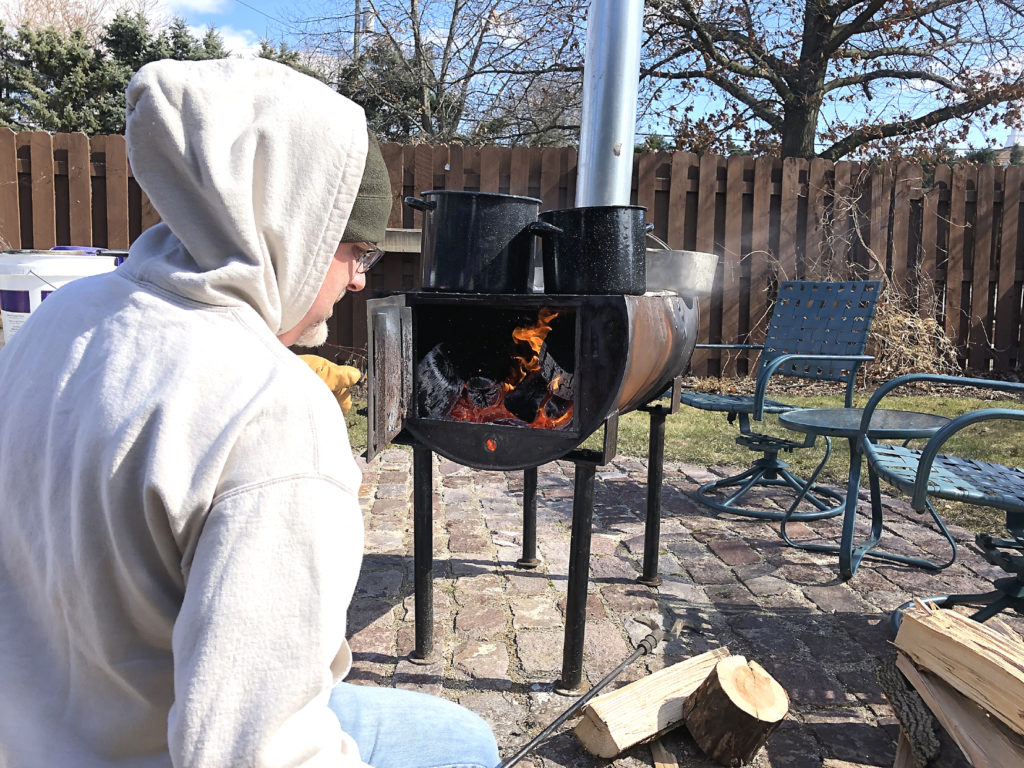
By Teddy Rydquist
Leader Staff Writer
The thawing of the ground, melting of the snow and return of relatively enjoyable temperatures have led to many spending more time taking in the great outdoors. For some, including Oxford Township resident Michael Alexander, this time of year means the return of a longtime hobby, collecting maple syrup, as well.
“I grew up around it as a kid in the small town of Wakarusa, Indiana,” Alexander shared of how his interest in the hobby began.
“The town is lined with maple trees and every year, end of March, first of April, we had our Maple Syrup Festival. So, that was where I was introduced to the real stuff. About six, seven years ago, I told my wife, ‘I want to start doing that myself.’
“I bought some taps from Amazon, got to collecting and figuring out how to do everything. A guy at our church, I found out he did it, so I learned some from him, too.”
Located in Elkhart County at Indiana’s northernmost point, Wakarusa’s annual Maple Syrup Festival dates to 1969.
According to industry estimations, 75 percent of all maple syrup in the United States is produced in New York and New England, but the area extends south to Tennessee and west to Minnesota.
The window for businesses and hobbyists to partake in the collection process is brief, lasting only about two months.
“This is the only time of year you can do it,” Alexander explained. “When the maple trees wake up and the sap starts to flow, so, you tap them about mid-February until the buds pop.
“When the buds pop and the trees start to blossom, you need to pull the taps because it releases an enzyme in the tree and ruins the sugar content of the sap.”
The collection of sap is a simple, but time consuming, process. The standard ratio is 40 gallons of sap yields one gallon of syrup. This transformation is done by boiling the water off using a stove, typically one of the wood-powered variety.
Alexander has already collected roughly 100 gallons of sap in 2020, enough to produce about two-and-a-half gallons of syrup.
“Last year (2019), we made about five gallons of syrup,” Alexander shared. “We give most of it away. The people at church really like it, there’s people in the community I’ve given it to it. It’s fun, I really enjoy it.
“Plus, I told my wife, come February, I just want to be outside. This gives me an excuse to be outside and do something.”
In addition to the time of year, the temperature plays a role in the sap collection process, too.
“The perfect day is when the temperature drifts in the low-20s at night, so the tree stops and goes into hibernation and stops flowing,” Alexander said. “Then, during the day, when it gets up to the high-40s or low-50s, the sap just flows.
“It all depends on the variety of maple tree, but in a season, you can typically get 10-20 gallons of sap per tap. So if you have two taps in one tree, you can get between 20 and 40 gallons from that tree.”
Spanning his yard, and three of his neighbors’, Alexander has 10 taps in-place this year. If Mother Nature cooperates, this could mean up to 200 gallons of collected sap, done using a five-gallon pail available at any hardware store.
Referring to the ratio, this puts him on pace with 2019’s five gallons. Alexander does not a specific number in mind, however, he just enjoys the hobby.
“We just collect until we stop,” he said. “Some years, you have more sap, this has been a really good year thus far.
“My wife helps me a lot, she helps me a lot. The kids help too, not so much with the boiling, but they help with the collecting. They definitely enjoy eating it.”
Per the Michigan Maple Syrup Association, our state is responsible for three-percent of the maple syrup annually produced in the United States. Our neighbors to the south, Ohio, have the slight edge in this department at four-percent.
With the hard work of Alexander and others in the community, perhaps Oxford can play their part in helping bump Michigan above the Buckeye State.
There are a couple of guidelines for interested parties to remember. When tapping a tree, the hole should be drilled approximately three inches deep and should be located two-four feet above the ground.
Twelve inches in diameter is recognized as the size when a tree can be tapped. Once a tree reaches 18 inches in diameter, two taps are allowed and three taps at 24 inches.

Leave a Reply